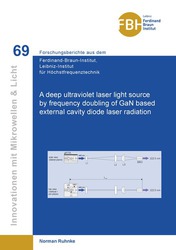| Areas | |
|---|---|
| Serie de libros (96) |
1378
|
| Nachhaltigkeit |
3
|
| Gesundheitswesen |
1
|
| Letra |
2364
|
| Ciencias Naturales |
5406
|
| Ciencias Ingeniería |
1793
|
| Ingeniería | 292 |
| Ingeniería mecánica y de proceso | 862 |
| Ingeniería eléctrica | 686 |
| Mineria y metalurgía | 30 |
| Arquitectura e ingeniería civil | 75 |
| General |
98
|
|
Leitlinien Unfallchirurgie
5. Auflage bestellen |
|
Erweiterte Suche
A deep ultraviolet laser light source by frequency doubling of GaN based external cavity diode laser radiation (Volumen 69) (Tienda española)
Norman Ruhnke (Autor)Previo
Lectura de prueba, PDF (210 KB)
Indice, PDF (47 KB)
A compact and portable laser light source emitting in the wavelength range between 210 nm and 230 nm would enable numerous applications outside of laboratory environments, such as sterilization and disinfection of medical equipment, water purification or gas and air analysis using absorption spectroscopy. Such a source is also highly attractive for the identification and quantification of proteins and biomolecules by means of laser-induced fluorescence or Raman spectroscopy.
In this thesis, a novel concept to realize such a compact and portable laser light source with low power consumption and an emission around 222 nm is investigated. The developed concept is based on single-pass frequency doubling of a commercially available high-power GaN laser diode emitting in the blue spectral range.
Due to the low frequency doubling conversion efficiencies in this wavelength range of about 10-4 W-1, a laser diode with high optical output power above 1 W is required as pump source. Moreover, it has to exhibit narrowband emission in the range of the acceptance bandwidth of the applied nonlinear BBO crystal.
Since GaN-based high-power laser diodes typically show broad emission spectra of Δλ = 1…2 nm, stabilizing and narrowing their wavelength by using external wavelength-selective elements is investigated and presented for the first time.
With the understanding for the novel concept gained in this work, a compact ultraviolet laser light source was realized. It has a power consumption of less than 10 W and is exceptionally robust due to its immoveable components. The demonstrated output power of 160 μW enables numerous industrial and everyday applications for which previous laser systems have been too complex and overly cost- and energy-intensive.
| ISBN-13 (Impresion) | 9783736976139 |
| ISBN-13 (E-Book) | 9783736966130 |
| Formato | A5 |
| Idioma | Inglés |
| Numero de paginas | 144 |
| Laminacion de la cubierta | mate |
| Edicion | 1. |
| Serie | Innovationen mit Mikrowellen und Licht. Forschungsberichte aus dem Ferdinand-Braun-Institut, Leibniz-Institut für Höchstfrequenztechnik |
| Volumen | 69 |
| Lugar de publicacion | Göttingen |
| Fecha de publicacion | 13.05.2022 |
| Clasificacion simple | Tesis doctoral |
| Area |
Ingeniería eléctrica
|
| Palabras claves | Laserdiode, GaN, InGaN, Diodenlaser mit externem Resonator, tiefes Ultraviolett, UV-C, kompakte Laserlichtquelle, 222 nm, 445 nm, Single-Pass, Frequenzverdopplung, Erzeugung der zweiten Harmonischen, Frequenzkonversion, Boyd-Kleinman-Theorie, Strahlformung, Phasenanpassung, nichtlineare Optik, nichtlinearer Kristall, BBO, Akzeptanzbandbreite, Konversionseffizienz, Emissionsspektrum, Volumen-Bragg-Gitter, Mikromontage, mikro-integriert, Oberflächenbeugungsgitter, Littrow-Winkel, Littrow-Konfiguration, optische Rückkopplung, Wellenlängenstabilisierung, Wellenlängenverschmälerung, Wellenlängen-Abstimmung, Modenauswahl, Modenunterdrückung, Raman-Spektroskopie, Resonanz-Raman-Spektroskopie, Absorptionsspektroskopie, Sterilisation, Desinfektion, Trinkwasseraufbereitung, laser diode, GaN, InGaN, external cavity diode laser, deep ultraviolet, UV-C, compact laser light source, 222 nm, 445 nm, single-pass, frequency doubling, second harmonic generation, frequency conversion, Boyd-Kleinman theory, beam shaping, phase matching, nonlinear optics, nonlinear crystal, BBO, acceptance bandwidth, conversion efficiency, emission spectrum, Volume Bragg Grating, micro-assembly, micro-integrated, surface diffraction grating, Littrow angle, Littrow configuration, optical feedback, wavelength stabilization, wavelength narrowing, wavelength tuning, mode selection, mode suppression, Raman spectroscopy, Resonance Raman spectroscopy, absorption spectroscopy, sterilization, disinfection, water purification |
| URL para pagina web externa | https://www.fbh-berlin.de/publikationen/dissertationen |








